Where and how to store pears correctly so that they do not spoil
Pear is a tasty but capricious fruit. It is important not only to obtain an abundant and high-quality harvest, but also to preserve it. To do this, varieties with high shelf life are planted, the fruits are kept under optimal conditions or processed. The article will tell you how to preserve pears for the winter and which varieties are suitable for long-term storage.
Features of pear storage
The main factor influencing crop storage is the time of harvest.. Fruits collected early do not have time to acquire the proper taste, ripen unevenly and are prone to diseases: bitter pitting, gray rot, bluish moldy and brown rot. When harvested late, the shelf life of fruits decreases and susceptibility to rot increases.
Reference! A characteristic feature of pears is their rapid ripening after picking.
The duration of fruit storage depends on the room temperature and humidity level: Pears lose water quickly due to their porous skin.
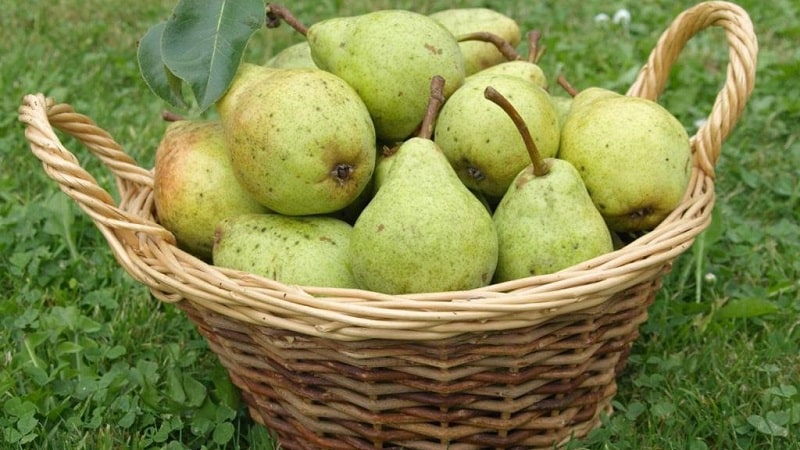
Selection and preparation of fruits
Only whole fruits without signs of disease are suitable for long-term storage., rotting and mechanical damage, collected in the phase of technical and botanical maturity along with the stalks.
The harvest is harvested in dry weather, distributed by variety and size, but not washed. Pears collected after the onset of frost, when the night air temperature has dropped below -15°C, are unsuitable for storage.
Varieties suitable for long-term storage
Among the varieties of crops with different ripening periods, the following varieties are distinguished: most suitable for long-term storage:
| Ripening period | Variety | Description |
| Autumn. They ripen in late August – early September. | Marble | The fruits are medium-sized and covered with thick, elastic skin. The pulp is tender and sweet. Trees tolerate air temperatures dropping to -25°C.
At a temperature of 0...+3°C, the crop is stored for 60–70 days. |
| Yakovlev's favorite | The trees reach a height of 3–8 m and can withstand frosts down to -30°C. The variety is prone to scab. Fruits with juicy fleshy pulp with a sweet and sour taste.
At a temperature of 0...+6°C and air humidity of at least 70%, the crop is stored for 3 months. |
|
| Victoria | The fruits are large, sweet and juicy. The variety is resistant to scab and bears fruit abundantly every year. Productivity: 180–200 kg per tree.
The shelf life of fruits at temperatures up to +5°C is 3-4 months. |
|
| Santa Maria | The variety was bred in Italy and is characterized by medium-sized trees, abundant yield (50–120 kg per tree), resistance to scab and frosts down to -30°C.
The harvest is stored for up to 2 months. |
|
| Autumn-winter. The harvest reaches technical maturity in mid-September - late October. | Bere Luke | The trees are 5–5.5 m high, the fruits are sweet with a slight sourness, weigh 200–400 g. Productivity is 43–54 kg per tree.
Fruits are stored at a temperature of +2…+3°C for up to 4 months. |
| Striyskaya | Trees up to 4.5 m high can withstand frosts down to -25°C. The fruits weigh 260–350 g, yield is up to 45 kg per tree.
Keeping quality - 4-5 months. |
|
| Winter. Frost-resistant varieties bred specifically for winter storage. | Pervomayskaya | The variety tolerates frosts down to -20…-25°C. Thanks to the waxy coating on the peel, the fruits are protected from pests and fungal diseases and are stored for 7 months. |
| Charles Cognier | Tolerates air temperature drops down to -3…-10°C.The fruits are sweet with chocolate notes and can be stored for 6-7 months. | |
| Saratovka | The harvest is harvested at the end of September and is stored for 3-5 months. The variety is resistant to scab and powdery mildew, and tolerates frosts down to -30°C. |
Read also:
How to properly store pears
Fruits are kept in boxes or on racks, laying them in 1-2 layers with the stalks up so that they do not touch each other.
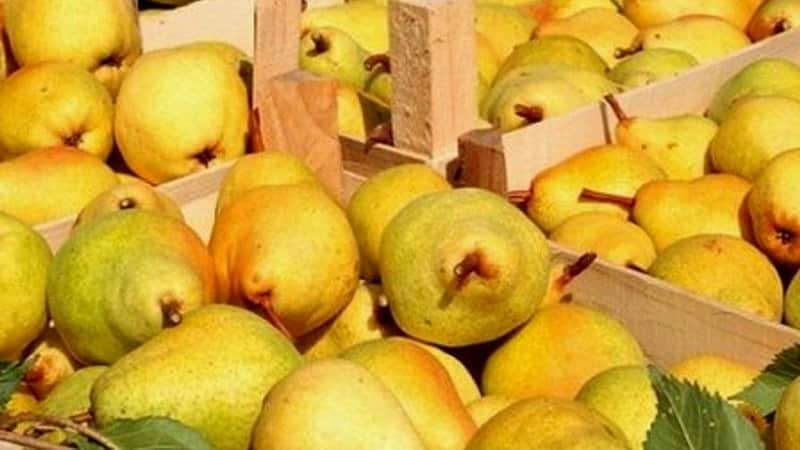
Optimal conditions
The crop is best stored in dark, well-ventilated areas. at a temperature of 0...+5°C and air humidity within 80–90%.
Important! Sharp temperature fluctuations provoke crop rotting.
Where to store
To ensure that the collected fruits do not lose their commercial quality and taste for as long as possible, it is important to choose the right place for storing them.
Cellar or basement
In the cellar or basement, pears are kept on racks and shelveslocated at least 20 cm from the ground. The room is pre-disinfected by fumigating with sulfur vapors for 2-3 days.
Optimum air temperature - +5°C, humidity - 85%. The room should be well ventilated and dark. When exposed to light, the crop is covered with a dark cloth.
Fridge
In the refrigerator, at a temperature of +3...+4°C, store only dense, not fully ripened dry fruits. They are pre-packed in plastic bags with holes for ventilation.
Freezer
In this case, the fruit is cut into small pieces and frozen for 2–4 hours at -30°C, if there is a temperature setting function. Then set to -18°C.
Room temperature
Many gardeners use a pantry or closet to store pears. To do this, the fruits are placed in a box with their tails up and sprinkled with sand or dry oak leaves.The room itself should be dark and well ventilated.
What to store in
Pears are kept in wooden boxes, which are first fumigated with sulfur to prevent mold and rot. and lined with thick paper or straw. The container must have ventilation holes, otherwise the fruit will quickly deteriorate.
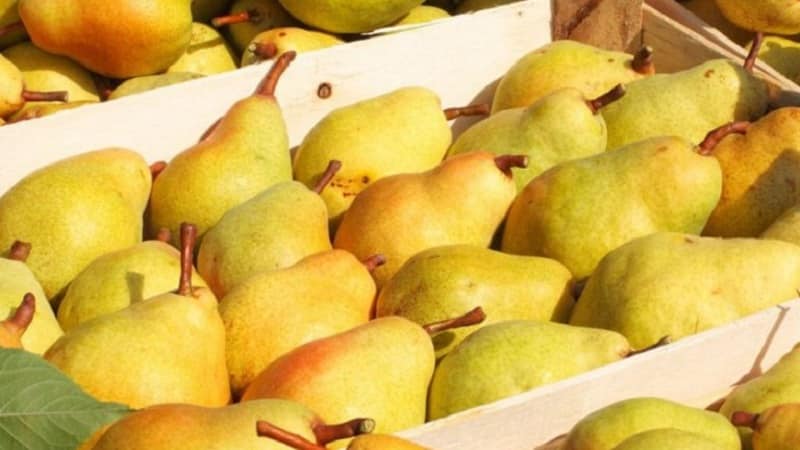
The height of the box should match the pears stacked in 2 rows. Paper, straw, peat, sawdust or dry moss are placed between them. They separate the fruits from each other so that they do not touch.
Reference! It is allowed to store pears in plastic bags, from which the air is pumped out before use.
No more than 15 kg is placed in the box fruits of the same variety.
Storage methods
The easiest way to store pears is to layer them with paper.. To prevent fruits from losing their taste and commercial quality for as long as possible, they are sprinkled with sand, sawdust, straw or a mixture of slaked lime and sawdust to prevent moisture loss.
If the harvest is small, each fruit is wrapped in wrapping paper. Newspapers are not used due to the toxicity of printing ink.
Can it be stored with apples and grapes?
High content in pears ethylene, which accelerates fruit ripening, will lead to premature spoilage of products stored nearby. Therefore, when planting vegetables and fruits, take into account the rules of their compatibility.
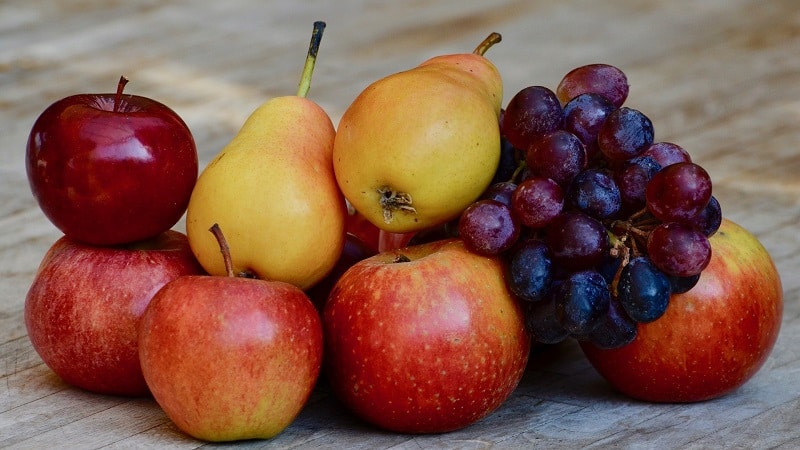
It is permissible to store pears and apples at a temperature of 0…+2°C and air humidity 90–95%. Only fruits that are not fully ripened are placed in boxes, which are sorted and inspected at least 2 times a month, promptly removing spoiled and darkened specimens.
Reference! Pears are not kept next to potatoes, cabbage, onions, celery, garlic and carrots.
Pears and grapes can be kept in the refrigerator for 10–15 days, but always in separate paper bags.
Features of storing unripe fruits
The harvest is harvested at the stage of technical maturity, when the fruits acquire a light blush, but remain solid. In order for the fruits to ripen on their own, they are left for 2–6 days in a well-lit room at a temperature of +18…+20°C, checking their condition twice a day. Almost ripe specimens are transferred to a cool (not higher than +5°C) place.
To speed up the ripening of pears, they are placed in one bag with apples or bananas.
Recycled storage
Fresh pears are suitable for consumption for a maximum of 7 months. To increase this period, fruits are processed: dried, frozen, canned or candied.
There are several drying methods:
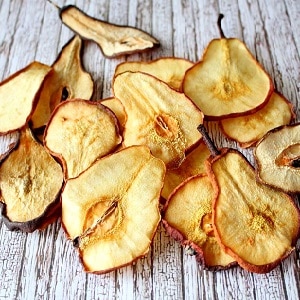 In the oven. The fruits are placed on a baking sheet and dried for 2 hours at +55…+60°C. Then the temperature is increased to +80°C, and after the pears are reduced in size, they are reduced to +55°C. The entire procedure takes 14–16 hours for slices and 18–24 hours for whole fruits.
In the oven. The fruits are placed on a baking sheet and dried for 2 hours at +55…+60°C. Then the temperature is increased to +80°C, and after the pears are reduced in size, they are reduced to +55°C. The entire procedure takes 14–16 hours for slices and 18–24 hours for whole fruits.- In an electric dryer. Thanks to uniform air circulation, the pears do not have to be turned over, and the presence of several pallets allows you to process up to several kg of fruit at the same time.
- In the microwave. At a power of 200 W, the pears are dried for 2-3 minutes. This is the fastest method, but due to the inability to accurately calculate the time, there is a risk of drying out or burning the fruit.
- On air. The pears are laid out on a surface (for example, baking sheets or trays) and placed in the sun, in a place where there is no dust or drafts. After 2 days, the fruits are transferred to a shaded place and left to dry for another 2-3 days.
Fresh fruits picked no more than 2 days ago are suitable for this treatment.. Dried fruits are stored in airtight containers: glass jars with tight lids or zip-lock bags in a cool, dark place.
Before freezing, wash the pears, cut them into 4 parts and remove the cores.. After this, the fruits are dipped in a lemon solution (juice of 1 lemon per 2 cups of water) for 30 seconds, dried on paper napkins or towels, placed in bags or containers and put in the freezer. They are frozen at -30°C and stored at -18°C.
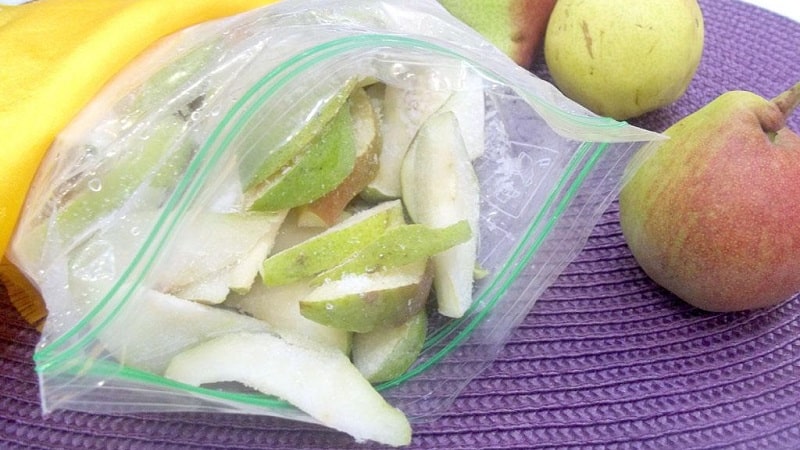
To prepare dried pears, cut them into slices, sprinkle with sugar and leave for 2-3 days. Drain the juice and dip the pieces into hot sugar syrup for 10 minutes. The slices are dried at +60°C in the oven for about 6 hours or in an electric dryer for 14 hours. In this form, fruits are stored in glass jars or paper bags at a temperature not exceeding +10°C and air humidity of 65–70%.
Pears can be preserved whole, pickled, used for making preserves, jams, compotes, juice or even wine. The preparations are stored in a cellar, pantry or on the balcony at a temperature not exceeding +5°C. Make sure that the containers are not exposed to direct sunlight.
Shelf life
The average shelf life of pears, depending on the chosen method and fruit ripening, is shown in the table:
| Storage method | Storage duration |
| In a refrigerator | Late varieties - 3-8 months, medium - 1-3 months, early - about 3 weeks. |
| Basement/cellar | Early varieties - 1-3 months, late - up to 7-8 months. |
| Room temperature | No more than 2 weeks. |
| Canned | No longer than 1 year. |
| Dried | At air temperatures up to +10°C - about a year, at room temperature - no longer than a month. |
| Dried in sugar | 12–15 months. |
| Frozen | 7–12 months. |
Useful tips
To preserve a fresh harvest for as long as possible, it is recommended:
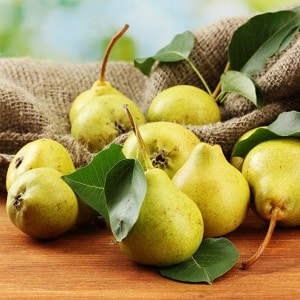 do not wait for the fruits to fully ripen, harvest in the technical maturity phase;
do not wait for the fruits to fully ripen, harvest in the technical maturity phase;- pick fruits together with the stalk, wearing fabric gloves;
- carefully inspect the fruits before storing them: you cannot keep specimens with signs of disease or mechanical damage, as they will ruin the entire harvest;
- put fruits in wooden boxes or cardboard boxes if there are few fruits;
- harvest in dry weather.
How to save the harvest until the New Year
Due to their harder skin, winter pears are characterized by long-lasting shelf life.. In proper conditions (dark, well-ventilated room with air temperature 0...+5°C and humidity 80–90%), they retain their taste and commercial quality until the New Year.
Early winter varieties (Cure, Nart, Elena, Noyabrskaya, Bere) are stored until January, late winter ones (Dekanka zimnyaya, Tikhonovka, Izumrudnaya, Maria) - until May, they take a long time to gain taste and are unsuitable for eating before December-January.
Conclusion
Despite the porous peel and specific structure of the pulp, pears are well stored at home. It is important to harvest the crop on time, take into account the requirements of the fruit for the temperature and humidity of the room, and constantly monitor the condition of the fruit.